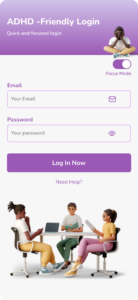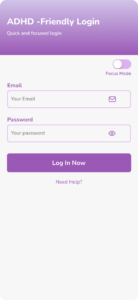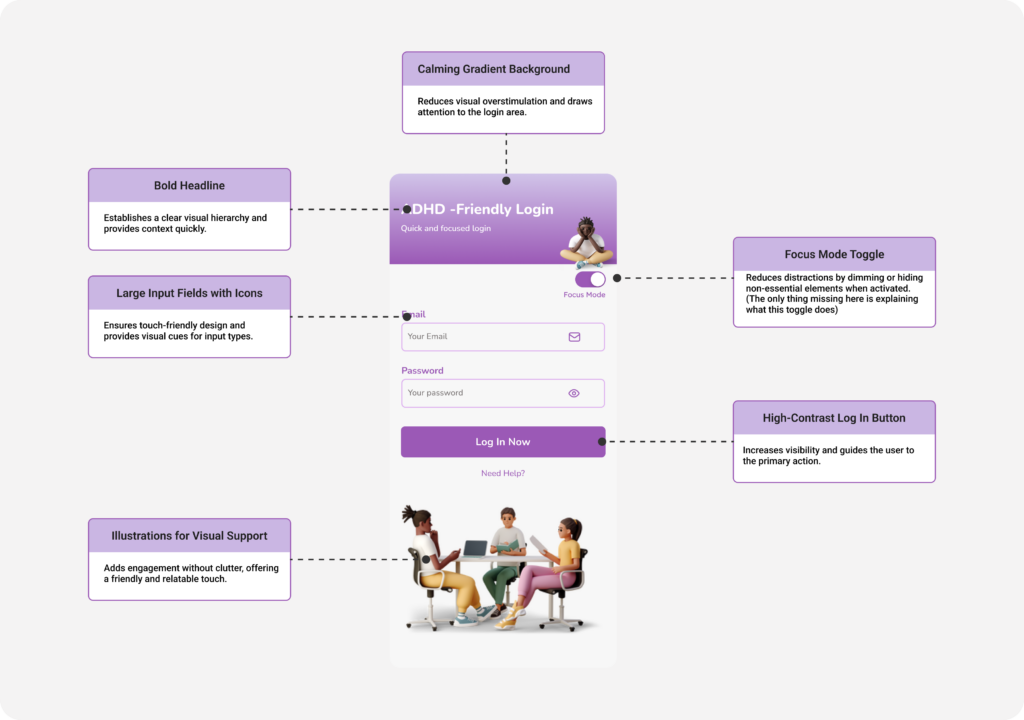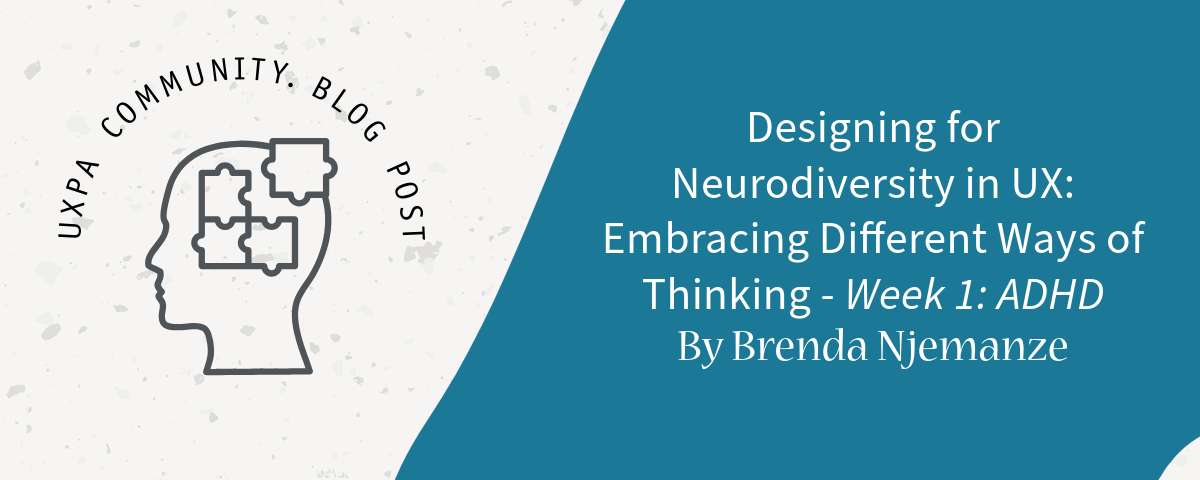Welcome to insights and stories from our wonderful UXPA Community! This new blog series is dedicated to showcasing our members and interesting UX topics. Our goal is to bring together various viewpoints from fellow UXers all over the globe. If you’d like to participate, please email volunteers@uxpa.org.
Designing for Neurodiversity in UX: Embracing Different Ways of Thinking
Imagine if the digital world didn’t look the same for everyone, but worked differently based on how our minds navigate it. For millions of neurodiverse people using technology can feel like solving a puzzle with pieces that don’t quite fit — whether it’s the constant distractions of ADHD, the reading struggles of dyslexia, or the sensory overload often faced by autistic individuals. While traditional approaches to accessibility tend to focus on physical and sensory needs, there’s another crucial aspect we need to talk about: cognitive diversity.
In this series, we’re exploring how UX design can better embrace the different ways people think and experience the online world. We’re not just going to discuss theories; we’ll look at real examples and practical strategies to make digital experiences more inclusive. Our focus will be on three conditions — ADHD, dyslexia, and autism — each with unique challenges and opportunities for more thoughtful design.
Meet Our Characters
To make this more than just abstract ideas, we’ll follow the stories of three individuals: Sarah, who lives with ADHD; Alex, who has dyslexia; and Emma, who is autistic. Their experiences will help us see digital interfaces through their eyes and understand how small changes in design can make a big difference in making the online world feel a little more welcoming.
Designing for ADHD in UX — Navigating a Busy World
Imagine you’re standing in a bustling marketplace. Vendors are calling out, music is playing from different corners, bright colors flash before your eyes, and the crows around you feels like it’s closing in. Now, imagine trying to read a book in the middle of all that. For someone with ADHD, navigating the digital world can feel just like that — overwhelming, noisy, and constantly competing for attention.
Meet Sarah, a young professional with ADHD who relies on technology every day for work communication, and entertainment. But for her, using websites and apps often feels like wading through that busy marketplace. There are distractions everywhere — pop-up notifications, complex menus, and flash animations. What should be a simple task, like logging in to an account or reading an article, quickly becomes frustrating because the design seems to be working against her.
This week, we’ll dive into Sarah’s experiences and explore how we can design digital spaces that help people like her feel more in control, more focused, and at ease.
The Digital Overload: Understanding ADHD in a Hyperconnected World
ADHD, or Attention Deficit Hyperactivity Disorder, affects the way people process information, making it difficult to stay focused, avoid distractions, and manage impulses. For Sarah, the digital space often feels like a carnival, full of bright lights and competing noises that constantly pull her attention in different directions. Websites with too many elements, busy interfaces, or distracting animations can become barriers to getting things done. She craves simplicity, but instead finds herself navigating environments that bombard her senses.
Picture trying to walk down a hallway, but every few steps, there’s a flashing sign, or someone is tugging at your sleeve, asking for your attention. That’s what using most digital interfaces feels like for Sarah — constantly navigating a world filled with interruptions.


Figure 1. ADHD-Friendly Login with the Focus Mode On
Figure 2. ADHD-Friendly Login with the Focus Mode Off
Designing With ADHD in Mind
To create digital experiences that work for users like Sarah, we need to clear the path and reduce distractions. Here’s how we can design an ADHD-friendly login interface (Figure 3):
- Simplify the Layout
Think of a cluttered interface as a maze, with too many twists and turns. Simplifying the layout by using plenty of whitespace and reducing the number of elements is like creating a well-lit, straight path — guiding users smoothly to their goal. - Focus Mode
The “Focus Mode” toggle helps reduce distractions by hiding non-essential content, just like putting on noise-canceling headphones in a crowded space. It creates a calmer environment where users can focus on the task at hand. - High-Contrast Buttons
Buttons that stand out with high contrast guide users toward the main action. It’s like placing a bright, clear signpost at every turn, making sure they know exactly where to go next. - Visual Cues
Icons and labels provide instant context, acting like signposts that tell users exactly what each field is for. This makes the interface easier to navigate, especially for someone who might struggle to keep their focus. - Minimal Animations
Animations can bring life to an interface, but they can also distract. Keeping animations subtle and slow ensures the design feels dynamic without overwhelming users. If used, animations should have an option to be turned off.

Figure 3. Designing for ADHD Using the 5 Steps
Let's Design for ADHD Together
I’d love to hear your thoughts. Have you ever designed with ADHD in mind? What worked for you and what didn’t? If you haven’t tried it before, I encourage you to take on the challenge. Create your own ADHD-friendly design and share it with the community. Practice makes perfect and there’s always room to grow in inclusive design.
Join us next time where we’ll be exploring dyslexia-friendly design. Let’s learn from each other, share our experiences, and work together to make the digital world a more welcoming place for everyone.
About Brenda
I’m a Product Designer who found my passion for design after earning a Master’s in Business Information Technology from Northumbria University Newcastle. With over 5 years of experience in product and project management, I’ve always been drawn to solving complex problems and creating impactful solutions. That journey led me to UX design where I discovered the perfect balance of strategy, creativity, and empathy.
My work spans industries like fintech and AI-powered property management where I focus on crafting intuitive, human-centered solutions. I’m also exploring how emerging technologies like AI can shape more inclusive and accessible designs.
For me, design is about empathy and curiosity — understanding people and creating experiences that make a difference. Whether it’s rethinking workflows or championing inclusivity, I’m committed to delivering meaningful, human-centered solutions.
Resources
To learn more about Neurodiversity and ADHD, here are some helpful resources.
ADDitude Editorial Team. (2024, November 15). ADHD guide. ADDitude Magazine. https://www.additudemag.com/category/adhd-add/adhd-essentials/
Bakken, H. (2022). Designing an online intervention for adults with ADHD [Unpublished master’s thesis]. The University of Bergen. https://bora.uib.no/bora-xmlui/handle/11250/3001949
Fessenden, T. (Host). (2024, August 23). UX accessibility and designing for neurodiversity (feat. Stéphanie Walter) (No. 41) [Video podcast episode]. In NN/g UX Podcast. NNgroup. https://www.youtube.com/watch?v=VgwitYuGP7Y
McKnight, L. (2010, June 12). Designing for ADHD: In search of guidelines [Workshop presentation]. IDC 2010 Digital Technologies and Marginalized Youth Workshop, Barcelona, Spain. https://homepage.divms.uiowa.edu/~hourcade/idc2010-myw/mcknight.pdf
Pun, K. (2016, SEptember 2). Dos and don’ts on designing for accessibility. Gov.UK. https://accessibility.blog.gov.uk/2016/09/02/dos-and-donts-on-designing-for-accessibility/
Sutterlin, K. (2023, September 7). How to design for neurodiversity: Inclusive content and UX [Webinar]. Interaction Design Foundation. https://www.interaction-design.org/master-classes/how-to-design-for-neurodiversity-inclusive-content-and-ux


